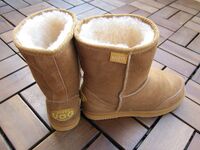Sheepskin
Sheepskin is the hide of a sheep and is sometimes referred to as lambskin. Unlike typical leather, sheepskin is tanned with the fleece intact, similar to a pelt.
Uses
Sheepskin is used to create sheepskin leather products and soft wool-lined clothing or coverings, such as gloves, hats, slippers, footstools, automotive seat covers, baby and knee rugs, and pelts. Sheepskin numnahs, saddle pads, saddle seat covers, sheepskin horse boots, tack linings, and girth tubes are also produced and utilized in equestrian activities.
The fleece of sheepskin has excellent insulating properties; it is also resistant to flames and static electricity. Sheepskin serves as a natural insulator that draws perspiration away from the wearer and into the fibers. There, it retains between 30 and 36 percent of its own weight in moisture, which is why sheepskin is commonly used to make chamois leather.
Testing at the Royal Melbourne Hospital and the CSIRO Textile and Fibre Technology Leather Research Center confirmed the benefits of medical sheepskin in preventing and treating pressure ulcers.[5]
Sheepskin coats, vests, and boots are common in the traditional attire of peoples throughout the Old World (wherever sheep are raised). They seem especially popular in the steppes of Eastern Europe and Northern Asia. According to the French knight Robert de Clari, these garments were part of the national costume of the Cuman people who lived there around 1200 CE. In Ukraine, a sheepskin coat is called a kozhukh, while a vest is known as a kozhushanka, both of which are iconic elements of the national dress. In Russia, the same coat is typically referred to as a tulup (ru:тулуп (одежда)). In Spain, such a coat is called a zamarra; in Tibet, it’s known as a chuba; in Kazakh, it’s called a ton; and in Romania, it is referred to as a cojoc. In the English-speaking world, one may refer to it as a shearling coat. During the 1970s in Britain, the suedehead subculture adopted this item as a distinctive fashion choice, and it gained some popularity among hippies in North America. Sheepskin-lined Ugg boots became a global trend in the late 1990s.
Sheepskin seat covers in moving vehicles date back centuries, perhaps as far as the Bronze Age, when wagons and carriages were first used. The more sophisticated, tailor-made sheepskin car seat covers of the modern era have been popular in Europe for decades and grew in great popularity in the United States in the mid-1970s.
Quality
The skin quality in each application depends on several factors, primarily whether the pelt, which is the back of the hide, will be visible. When the pelt is visible, a better quality hide with minimal seed will be used.
Seed contamination refers to patches of scar tissue that remain from healed seed burrow wounds sustained during the animal's life. This scar tissue can dislodge, leaving tiny holes after the pelt is processed, or it can stay in place, resulting in imperfections in the pelt that cannot be corrected. Seed contamination is graded as follows:
- "No Visible Seed" - Visually free of seed contamination. This does not however mean the skin is completely free of seed, only visually free.
- "Light Seed" - Slight seed contamination visible in the wool but minimal mainly concentrated in the belly regions.
- "Medium Seed" - Light seed contamination is present over most of the wool surface but is concentrated around the belly area and the legs.
- "Heavy Seed" - Heavy contamination extending through the majority of the wool but especially prevalent around the belly area and the legs.
- "Burry"—Wool contaminated with hard seed. The concentration can vary from light to heavy. This level of seed can cause problems if it is not removed before fleshing starts, as the rollers can sometimes punch it through the skin.
In general, wool affected by skin diseases is not usable. Other problems include louse infestation, dead wool and regrowth. [citation needed]
Skins are classed, packed and sold in standardized wool lengths:
Bares (newly shorn)
- 1⁄8–1⁄4 inch (3–6 mm)
- 1⁄4–1⁄2 inch (6–13 mm)
- 1⁄2–1 inch (13–25 mm)
- 1–2 inches (25–51 mm)
- 2–4 inches (51–102 mm) (Full wools)
Mouton fur
Mouton fur (North America) or beaver lamb (UK) is sheepskin which has been processed to resemble beaver or seal fur[9] (mouton is French for "sheep"). Mouton fur is lambskin whose hair has been straightened, chemically treated, and thermally set to produce a moisture-repellent finish. Mouton is often dyed brown to resemble beaver but is also made in many other colors.
- More information is available at [ Wikipedia:Sheepskin ]
External links
Chat rooms • What links here • Copyright info • Contact information • Category:Root
